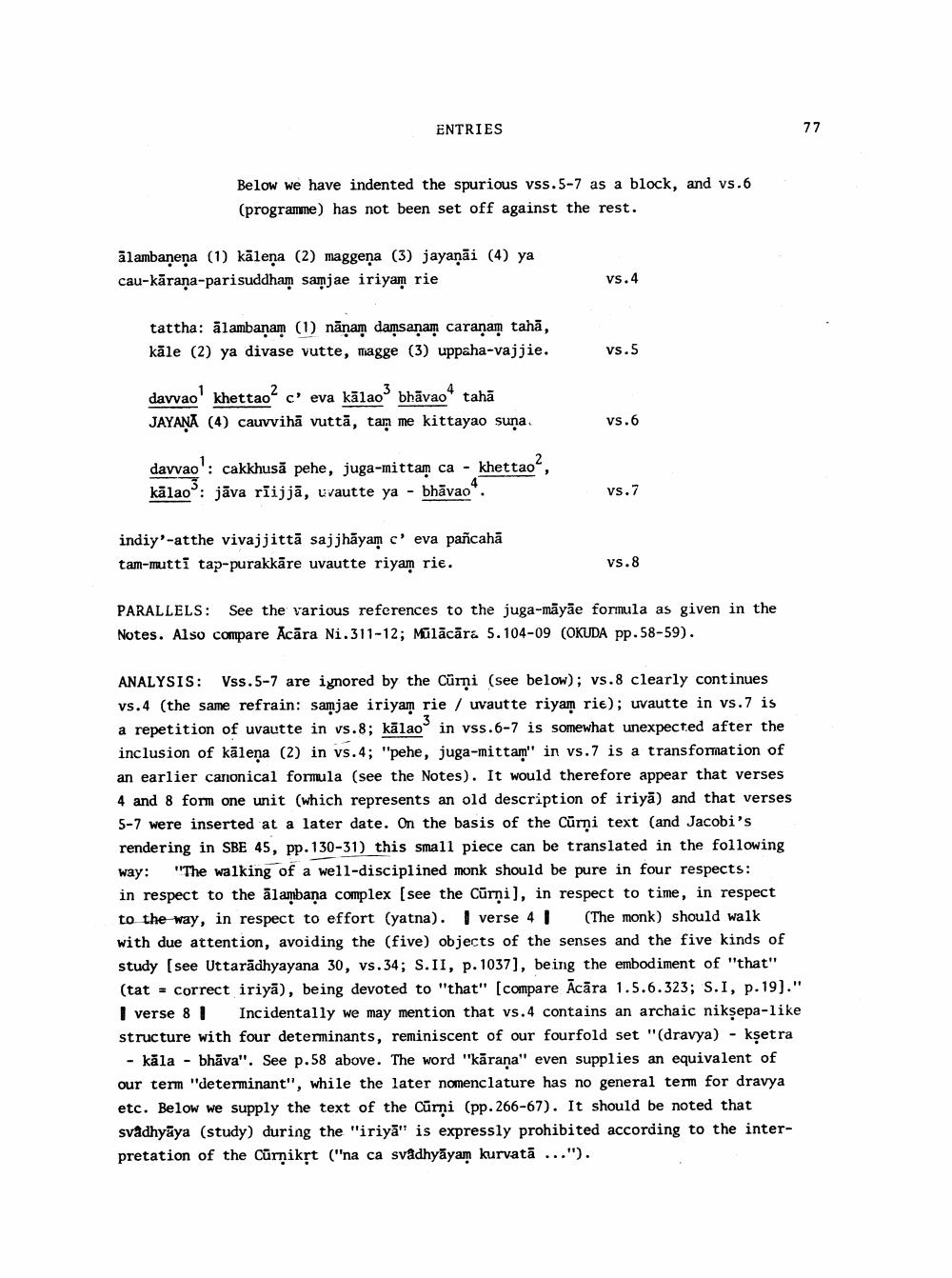________________
ENTRIES
Below we have indented the spurious vss.5-7 as a block, and vs.6 (programme) has not been set off against the rest.
ālambanena (1) kālena (2) maggena (3) jayaņāi (4) ya cau-kāraņa-parisuddham samjae iriyam rie
vs.4
tattha: ālambanam (1) nānam damsanam caranam tahā, kāle (2) ya divase vutte, magge (3) uppaha-vajjie.
vs.5
davvao' khettao? c'eva kālao bhāvao4 tahā JAYAŅA (4) cauvvihā vuttā, tam me kittayao suna.
vs.6
davvao': cakkhusă pehe, juga-mittam ca - khettao, kālao: jāva riijjā, uvautte ya - bhāvao.
vs.7
indiy'-atthe vivajjittā sajjhāyam ceva pañcahā tam-mutti tap-purakkāre uvautte riyam rie.
vs. 8
PARALLELS: See the various references to the juga-māyāe formula as given in the Notes. Also compare Acāra Ni.311-12; Mülācāra 5.104-09 (OKUDA pp. 58-59).
ANALYSIS: Vss. 5-7 are ignored by the Cürņi (see below); vs.8 clearly continues vs. 4 (the same refrain: samjae iriyam rie / uvaut te riyam rie); uvautte in vs.7 is a repetition of uvautte in vs.8; kālao in vss.6-7 is somewhat unexpected after the inclusion of kālena (2) in vs.4; "pehe, juga-mittam'' in vs.7 is a transformation of an earlier canonical formula (see the Notes). It would therefore appear that verses 4 and 8 form one unit (which represents an old description of iriyā) and that verses 5-7 were inserted at a later date. On the basis of the Cūrņi text (and Jacobi's rendering in SBE 45, pp. 130-31) this small piece can be translated in the following way: "The walking of a well-disciplined monk should be pure in four respects: in respect to the alambana complex (see the Cūrņi), in respect to time, in respect to the way, in respect to effort (yatna). verse 4 (The monk) should walk with due attention, avoiding the (five) objects of the senses and the five kinds of study (see Uttarādhyayana 30, vs.34; S.II, p. 1037), being the embodiment of "that" (tat = correct iriyā), being devoted to "that" (compare Ācāra 1.5.6.323; S.I, p.19)." | verse 81 Incidentally we may mention that vs.4 contains an archaic nikṣepa-like structure with four determinants, reminiscent of our fourfold set "(dravya) - kşetra
- kāla - bhāva". See p.58 above. The word "kāraņa" even supplies an equivalent of our term "determinant", while the later nomenclature has no general term for dravya etc. Below we supply the text of the Cūrni (pp. 266-67). It should be noted that svadhyāya (study) during the "iriyā" is expressly prohibited according to the interpretation of the Cūrnikrt ("na ca svadhyāyam kurvatā ...").




